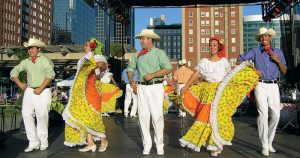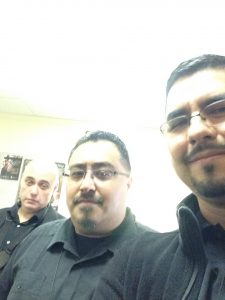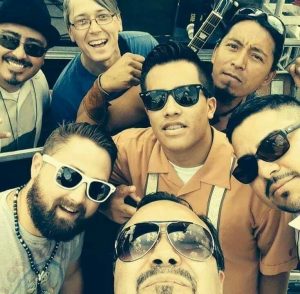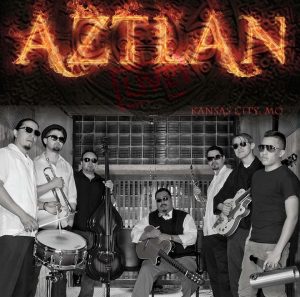By José Angel Sustaita
Mexicans have been in Kansas City since the early 1900’s. Some came as to work in the packing plants and others came to work for the railroad. Many families settled in barrios such as the Westside and the West Bottoms in Kansas City Missouri. On the Kansas City, Kansas side, they lived in Argentine, Armourdale and Rosedale. When they arrived in Kansas City most of the Mexicans faced racial and language barriers. Many landlords refused to rent to Mexicans, causing them to live in railroad boxcars or other shanties.1 This was a very common situation that the newly arrived had to deal with making it difficult to settle in. The majority of the people were of the Catholic religion but even then, there weren’t any catholic services available. There were other social service providers here. But at that time, due to social discrimination, they would not serve our people. The travesty was that our people didn’t even feel welcome at the Catholic churches and therefore did not attend on a regular basis. They set up masses in storefronts down the street and even in a boxcar. 2 While having to go thru rough times of not being accepted nor being recognized in a new home, we still manage to keep pushing forward. By not forgetting who we are and where we came from, we pass along important family values.
Tradition
We hold on to our traditions and culture by expressing ourselves thru music remembering our experiences and acknowledging our identity as Latinos in Kansas City. Some of the traditions that we continue to celebrate are baptisms, quinceañeras, weddings, anniversaries, graduations, birthdays and anything else that we can think of to celebrate with an occasional divorce party too. We love to celebrate and that’s part of our culture. As a result, there would be annual fiestas at churches which included dancing, food and live music form local musicians.

Families would gather from the communities and celebrate fiestas like Cinco de Mayo, El Grito de Independencia on September the 16th and church fundraisers. One of the earliest fiestas in Kansas City was at the Guadalupe Center in 1926 with a reported attendance of 5,000 community members. 3 There still are churches that hold fiestas on a yearly basis in the KC metro area. In Kansas City, Missouri, there is Sacred Heart-Guadalupe church in the Westside and Guardian Angels in Westport. In Kansas City, Kansas, there is an annual ice cream social at Holy Name church and St. Joseph/St. Benedict used to have them on a yearly basis too. There would also be fiestas at a couple other churches that are no longer open. Those churches were St. Thomas church in Armourdale, and at St. John the Divine in Aregntine.

There are other yearly fiestas in Kansas City that are not held by churches or religious institutions. Fiesta Hispana is held yearly on September at Barney Allis Plaza with a Fiesta Mexicana coming soon every Cinco de Mayo that will also be held at the Barney Allis Plaza. There is also a fiesta that is held on Central avenue in September and has doubled in size.
Musical Influence
Music is a language that is spoken to and by everyone, no matter if you are a musician or a music lover. Music has a way of being a part of a person’s life on a daily basis. It can reflect the type of mood you are in or the type of day you are having. It’s there for us when we are happy and when we are sad. It brings us together in good times and in bad. Music has played an important role in all the barrios on both sides of the state line in Kansas City. When people think of music in Kansas City, they think of jazz music. When people think of Mexican music in Kansas City, they think of a Mariachi. Mariachis most commonly use violins, trumpets, guitars, and a guitarrón, charro outfits and sombreros. This would be the most common picture that would pop up in a person’s mind without considering that there are other genres of Mexican music in Kansas City.
Most people probably don’t realize that Mexican music is not the only Latin music in Kansas City. Latin music has evolved so much that it has a crossed over into the homes of other nationalities. It has become a common language among musicians and is spreading like wildfire. Latin music is made up of many genres from different Latin American countries which also include the influence of jazz and African percussive rhythms and can be heard in Latin Jazz and Salsa.
The Mariachi
The roots of the Mariachi go back hundreds of years. It was the music of country people; music that celebrated the joys, the struggles and the triumphs of the Mexican people. 4 Kansas City has been blessed to have mariachi music since the 70’s and continues to alive and strong with much presence from the new generation of mariachi players. Don Beto Lopez Sr. has played mariachi music for over forty years now and continues to do so. Beto Lopez began playing trumpet for a Kansas City group called “Mariachi Tropical” in 1976, and for other local groups such as “Eduardo y Los Trovadores” on occasion. In 1979, a number of the musicians from “Mariachi Tropical” split to form a new group called “Mariachi Mexico” which has not varied in personnel since that time. 5 Mariachi Mexico had been the only mariachi in town for many years with an occasional other one that would form but wouldn’t last very long. To date, there are possibly five to six existing mariachi groups in Kansas City.
A new generation of Mariachis are coming up thru the ranks with the help of the mariachi program that started at Atla Vista Middle School in the Westside. The program was started in 2010 with the help of Luis Alonso Portillo as the music director. This is the first youth mariachi in the Kansas City area. Atla Vista high school also offers the mariachi program for students that wish to continue after middle school. Kansas USD 500 school district has recently started their own youth mariachi program and has attracted many students that have joined since.
Interviews
I had the pleasure of interviewing two of my good friends that are local musicians. They are both very much involved in the music scene in Kansas City and are also Music directors. They are bandmates of mine and we perform together on a weekly basis. They are more than bandmates, they are family to me and we share a passion that will live on after we gone. They are sharing their knowledge with our future musicians that will keep our tradition and culture of music alive.
Luis Portillo
Luis Portillo was born in Parral Chihuahua, Mexico in 1969 and came to the United States when he was nine months old. His father came here to work in the united states and the sent for the rest of the family. He grew up in a black and white world with very few first-generation Latinos in elementary school. Luis grew up in both sides of the state line attending several schools and ended up graduating from North East high School. His main activities that he participated in school was music. His first musical instrument in school was a stringed instrument called the cello during the fourth grade. He has already been exposed to the guitar and was taught by his father. His father had promised to buy him a motorcycle only if he was able to play a “C” chord. After having spent the whole day in the basement learning to play that chord, his father kept his promise and bought him a motorcycle. It didn’t work but he kept his promise. His father taught him how to play guitar by having him sit down and watch him play. He would later show him basic chords on the guitar and learning how to play by ear.
Mexican folk music was his first experience in learning part of his tradition. Pedro Infante, Jorge Negrete are a couple of Mexican folk singers that his father had him listen to. He also listened to music on the radio and recordings of Juan Gabriel, Los Bukis, The Beatles and Led Zeppelin. There was no limit to the different genre of music that he would listen to. He would listen to just about everything. He used this to his advantage and was able to apply this knowledge to his music playing.
Luis would later change instruments in the eighth grade, from the cello to the baritone saxophone. He explains the reason for this is because the Kansas school district had strings and wind instruments and the Missouri school district only has the winds instruments available. Learning to play the saxophone opened doors for Luis as he joined his first band outside of school in the ninth grade. Luis continued his musical education after high school by studying at the music conservatory at UMKC and graduated in 1996. He has performed with numerous amounts of bands in Kansas City while attending school. The list of bands starts out with La Sorpresa, Los Tarahumara, Sensacion Latina, Siboney, Tropical Azul, Mambo de Leon band, and eventually with Trio Aztlan. He is one of the three original members of Trio Aztlan and has been with them for twenty-five years now.
Trio Aztlan was made up of three musicians named Dr. Uzziel Pecina, Luis Portillo and Hector Aguire. Their performance debut was at Manny’s Mexican Restaurant in 1993.They only had thirteen songs in their set list and had to keep repeating the same songs over and over every Friday and Saturday night. The three of them had different musical backgrounds. Uzziel didn’t read music but had always wanted to play guitar and sing in a mariachi. Uzziels biggest music influence at the time was Los Lobos and wanted to follow their style of music. Luis Portillo was a trained musician, could read music and had the most experience. Luis biggest music influence at the time was more into the classical, Mexican folk, traditional guitarist. Hector Aguire didn’t read music and is extremely talented. Hectors biggest influence was flamenco music.

Original members of Trio Aztlan
Left – Hector Aguire
Middle – Uzziel Pecina
Right – Luis Portillo
Luis followed a career as a band director and took on his first professional teaching job at Central middle school in Kansas City Kansas. He taught band and strings for seven years from 1996 to 2003. He ventured on to California to pursue other career in real estate and decided to continue teaching music. He stayed in California teaching music until 2010 and made the decision to come home to Kansas City. Upon returning to Kansas City, he took a position at Alta Vista middle school directing the first youth mariachi in Kansas City. He has worked with students from different backgrounds and nationalities. The parents and the community were very supportive of the program and continue to give support after Luis moved on to other opportunities at Center school district. Luis future plans is to focus on the business side of music but will continues to grow and share his knowledge with his students and musicians.
David Cunningham
David Cunningham was born in small town of about three thousand people called Elkton Kentucky in 1981. He grew up on his family farm and has fond memories of being there and at church. His town only had one public school in the county and everyone knew everyone. His activities in school were primarily playing trumpet in the school band. He started out his musical career by singing in the church choir alongside of his mama. He also learned to play the guitar and piano with a blue grass/ gospel background. His mother and his grandfather were his influences and encouraged him to sing in church. His family was 100 percent supportive of him wanting to learn and play music.
In middle school he was given the choice of instrument to pick out in band class. He originally started with the trombone and moved over to the trumpet which was his first choice. He studied classical methods for the trumpet and some jazz as he progressed as a player. David doesn’t have a specific genre that influences his music because he tries to keep his ear open for all music, old and new. He likes the new music that is being made locally in Kansas City. Being exposed to new music and new instruments has given him the opportunity to experiment what has learned and apply that with other bands. Being able to read music and play by ear has helped him advance as a musician.
David studied music education at college in Bowling Green Kentucky and wanted to teach music to children. He studied both vocal and instrumental methods to be marketable. David had to take teaching classes at the education building to be able to work with children. He would take breaks from all the studying by playing in the school marching band, basketball band and wherever he could play to get away. He played in a funk band called “Black cherry Kool aide” covering music by Kool and the gang and would play at small clubs to blow off steam.
David came to Kansas City in 2006 and started teaching at Brookside charter school on Troost avenue. He was put to the test as he took on a new job in a new city without knowing what to expect. He had been exposed to teaching children while in college but was not prepared for his first professional job. He was getting ready to teach K thru 5 and was frightened by the thought of it. David said that the crash course turns out to work out for him after all. David learned to teach from the older teachers while he was there for five years. He left Brookside charter school and went to be the music director at Center Elementary school where he is still teaching.
Getting into the music scene was not hard for David. He started to attend jam sessions at places like The Phoenix and The Blue Room. He introduced himself and started to network with other musicians from the area. He made it his mission to find and reach out as many musicians as he possibly could. He remembers Stan Kessler being one of the first musicians he met out in the music scene. Musicians had told David to listen to Stan and the Suns of Brazil and so he did so. He has had the pleasure of meeting many talented jazz musicians and as he put it” Some of the best Jazz musicians are in Kansas City and can play anywhere in the world”. David gives credit to all the great jazz musicians that he has met in Kansas City.
David mentioned that he has always kept an ear open to all music and on genre that caught his attention was Latin music. David married into a Mexican family was a new experience for him because he didn’t grow up around any Mexicans. Learning the culture, listening to the language and the music was fascinating for him, it was like living in a different world. David had played some Latin jazz songs in college and was hungry to get a chance to play more of it in KC. One of the first Latin bands he came across was Mambo De Leon who had a salsa band that was very popular.
David recalls meeting Luis Portillo in 2010 when Luis was moving back to KC from California. David’s wife Sandra, is a cousin of Luis Portillo by marriage and she made the introduction. Luis invited David to join in on a couple of tunes at a Trio Aztlan performance and he kept coming back for more. Luis was playing bass during that time while the bassist (me-Jose) was out of town working. David recalls stalking the Trio Aztlan gigs and showing up to play at the gigs. He has been a member since the and will continue to be number six. He also plays trumpet with other talented musicians in Latin bands like Mundo Nuvo and Maria the Mexican.
Trio Aztlan doubled in size and continues to go by Trio Aztlan because of the original traditional bolero style of music they had started with. Aztlan is now made up by Dr. Uzzile Pecina – guitar and vocals, Luis Portillo – sax, guitar and vocals, Jose Angel Sustaita – upright bass and vocals, Andres Ramiz – percussion, Kevin Sweet – guitar and vocals and last but not least, David Cunningham – trumpet and percussion. They still perform at Manny’s every first Friday and third Saturday of every month.


Trio Aztlan rehearsal – Living room Sessions- 2015
Song medley – Amaneci Otra Ves – vocals -Dr. Uzziel Pecina,
Mi Tesoro – vocals – Jose Angel Sustaita
Musicians from left to right – Jose Angel Sustaita – upright bass, Kevin Sweet – electric guitar, Luis Portillo – soprano sax, David Cunningham – trumpet, Dr. Uzziel Pecina – Acoustic guitar, Andres Ramirez – percussion (not in video)
- “The “Godmother of Guadalupe”.” Swope Park, Swimming Pool | KC HISTORY. Accessed May 10, 2018. http://www.kchistory.org/week-kansas-city-history/godmother-guadalupe.
- https://mospace.umsystem.edu/xmlui/bitstream/handle/10355/3459/QueVivaElWestside.pdf?sequence=1&isAllowed=y
- https://mospace.umsystem.edu/xmlui/bitstream/handle/10355/3459/QueVivaElWestside.pdf?sequence=1&isAllowed=y
- History of Mariachi Music. Accessed May 10, 2018. http://web.nmsu.edu/~lleeper/pages/Voice/marrujo/history.htm.
- History of Mariachi Music. Accessed May 10, 2018. http://web.nmsu.edu/~lleeper/pages/Voice/marrujo/history.htm.
- “Latino Community in Kansas City.” Visit KC. June 07, 2017. Accessed May 10, 2018. https://www.visitkc.com/visitors/things-do/trip-ideas-tools/discover/diversity/latino-community-kansas-city#sm.001irddw318kcf03pxp11lh9lv65w.